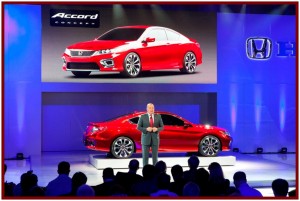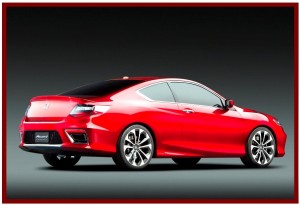
The new 2013 Accord is a chance for Honda to find its way back to the core values and marketplace successes of the past. This road home starts at Marysville next fall.
The Honda Accord coupe ‘concept’ shown for the first time at the NAIAS previews an all new 2013 model Accord line, which among other things will see the debut of Honda’s first Plug-In Hybrid Vehicle as the ninth generation Accord appears in the U.S. next fall.
The 2013 Accord will have two other substantially revised powertrains, a 2.4-liter direct-injected engine and a 3.5-liter V6 engine both mated – finally – to a new 6-speed automatic transmission. The six-speed automatic is significant, as Honda, once a leader in fuel economy, still offers in the Accord with a less efficient 5-speed automatic transmission in a segment dominated by 6-speeds, with 8-speed and 10-speed transmissions under development at other makers.
Given the competitiveness of the segment – accounting for ~20% of the cars sold in the U.S., Honda is currently behind in technology. This is an unexpected, image damaging lag for a company that used to reside at the top of the automaker innovation scorecard. (See 2011 Honda Accord Freshening)

“We’re here to serve notice to the competition that Honda is firing on all cylinders cheap neurontin again,” claimed John Mendel, executive vice president of sales for American Honda.
Now wonder then that Honda claimed both the upcoming Accord Sedan and Accord Coupe models are “expected to achieve class-leading fuel economy ratings.” The Plug-In Hybrid Accord will travel up to 15 miles on electric power alone, with the driver able to control up to appoint when the vehicle operates in all-electric mode, the same as the 2012 Toyota Camry hybrid which went on sale last fall.
Some of Honda’s current problems resulted from a large drop in Honda R&D spending since 2008 when the reckless practices of Wall Street resulted in the ongoing economic crisis. Then there were some decidedly mediocre new products including a mildly revised Civic last year and the fuel guzzling, inefficiently packaged (but highly styled) CrossTour, which was well underway when fuel prices soared.(In an attempt to recover Honda has just announced a more fuel-efficient 4-cylinder engine version.)
Throw in the production interruptions caused by the tragic Japan earthquake and Thailand floods, and Honda and Acura finished 2011 with sales down 7% in total in a U.S. market that grew 10%. Has Honda has lost its way or is this is just a temporary rest stop before returning to the roadways? The Accord, a perennially Honda best seller globally, is possibly the comeback car.
“We’re here to serve notice to the competition that Honda is firing on all cylinders again,” said John Mendel, executive vice president of sales for American Honda at the NAIAS press preview in Detroit this week.
Many of the Accord claims Mendel made were actually foreshadowed at the Tokyo Motor Show this fall when Honda CEO Takanobo Ito said Honda aims to achieve industry leading fuel economy for every category it’s in within three years. Japan’s third largest automaker also said it would reduce CO2 emissions by 30% for all products sold worldwide by 2020, compared to Honda emission figures for 2000. (See Honda to Show AC-X Plug in Hybrid at Tokyo Motor Show)
The Honda program called “Earth Dreams Technology,” in a very rough translation, is actually a series of efficiency and fuel economy boosting measures for engines, and transmissions, as well as electric-powered motors using existing or emerging technologies. Variable valve timing, direct injection, the Atkinson cycle, hybrid vehicles, turbocharging and friction reduction are part of the plan’s proposed techniques. (See Honda Claims it will lead in Fuel Economy in All Classes within Three Years. New EVs and Hybrids Coming)
Honda, of course, is not the only automaker to be frantically pursuing increased vehicle, engine and electric motor efficiency – whether stated publicly or not – because of ever tightening global emission and CO2 standards. It’s simply the price of survival. Since all of the technologies cited are well know, with many in production at other automakers, the secret to success will be which company can execute fuel efficiency plans at the least cost.
Part of the Honda solution is weight reduction. While the Accord Coupe will remain similarly sized, the 2013 Honda Accord Sedan will finally become smaller after eight generations of waxing larger. Both the Accord Sedan and Accord Coupe will retain the current model’s interior space, though.
The Accord, of course, was the first Japanese-nameplate car assembled in the United States way back in 1982 when Accord was being made in Japan and in a brand-new automobile assembly plant in Marysville, Ohio. The Marysville plant is the sole global source of the Accord Coupe.
The success of that Accord set a path for Honda’s huge American expansion, which propelled it into the automotive big leagues,- as it was a weak, fourth place automaker in Japan at the time, and was looked at in derision by major Toyota and Nissan (Datsun). Ultimately Marysville proved that building cars in America was a viable proposition to skeptical and chauvinistic Japanese executives at Nissan and Toyota, who eventually followed Honda in the U.S. The new 2013 Accord is a chance for Honda to find its way back to the core values and marketplace successes of the past. This road home starts at Marysville next fall.

